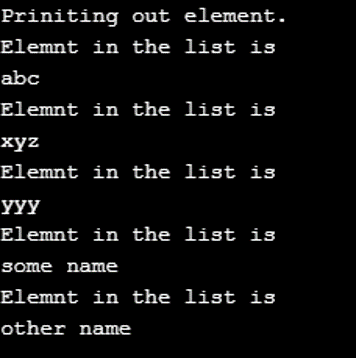
ArrayList est l'implémentation de l'interface List, qui relève du framework de collection en Java qui nous permet d'augmenter la taille d'un tableau de manière dynamique, c'est-à-dire au moment de l'exécution. Cette classe est disponible dans java.util.package en interne, elle utilise la structure de données du tableau. ArrayList autorise uniquement les classes wrapper en Java et l'utilisateur définit les classes.
Commencez votre cours de développement de logiciels libres
Développement Web, langages de programmation, tests de logiciels et autres
Syntaxe :
ArrayList<T> list = new ArrayList<>();
List<T> list = new ArrayList<>();
Nous pouvons utiliser directement une instance de ArrayList ou l'attribuer à une référence List.
Constructeurs :
Dans la liste des tableaux, nous avons trois constructeurs disponibles, qui sont les suivants :
Voici les méthodes de la classe Java ArrayList :
Examples of Java ArrayList Class are given below:
The below example will show how to add an element to an array list.
Code:
package com.cont.article;
import java.util.ArrayList;
public class ArratListTest {
public static void main(String[] args) {
ArrayList<String> list = new ArrayList<>();
list.add("abc");
list.add("xyz");
list.add("yyy");
list.add("some name");
list.add("other name");
System.out.println("list is :: " + list);
}
}Output:

Code:
import java.util.ArrayList;
public class Main {
public static void main(String[] args) {
ArrayList<String> list = new ArrayList<>();
list.add("abc");
list.add("xyz");
list.add("yyy");
list.add("some name");
list.add("other name");
ArrayList<String> list2 = new ArrayList<>();
list2.addAll(list);
System.out.println("Elements in list one : " + list);
System.out.println("Elements in list two : " + list2);
}
}Output:

Code:
import java.util.ArrayList;
public class Main {
public static void main(String[] args) {
ArrayList<String> list = new ArrayList<>();
list.add("abc");
list.add("xyz");
list.add("yyy");
list.add("some name");
list.add("other name");
System.out.println("Size of list before remove ::" + list.size());
System.out.println("Elements in list are before remove " + list);
list.remove(4);
System.out.println("Size of list after removinf element :: " +list.size());
System.out.println("Elements in list are after remove" + list);
}
}Output:

Code:
import java.util.ArrayList;
public class Main {
public static void main(String[] args) {
ArrayList<String> list = new ArrayList<>();
list.add("abc");
list.add("xyz");
list.add("yyy");
list.add("some name");
list.add("other name");
list.clear();
System.out.println("Clering all elements of list " +list.size());
}
}Output:

Code:
import java.util.ArrayList;
public class Main {
public static void main(String[] args) {
ArrayList<String> list = new ArrayList<>();
list.add("abc");
list.add("xyz");
list.add("yyy");
list.add("some name");
list.add("other name");
System.out.println("Priniting out element.");
for (String string : list) {
System.out.println("Elemnt in the list is");
System.out.println(string);
}
}
}Output:

The array list in java does not contain duplicate elements. Also, the insertion order is maintained in a list, which means we put over elements that will generate the output in the same sequence. Some detailed points which need to be remembered for the array list in java are as follows:
It implements various interfaces:
The class hierarchy is as follows:
java.lang.Object >> java.util.AbstractCollection<E> >> java.util.AbstractList<E> >> java.util.ArrayList<E>
By default, the array list is not synchronized in nature and is not thread-safe, But we can make them synchronized using the collections class synchronized method. The syntax is described below for reference :
List arrList = Collections.synchronizedList (new ArrayList(...));
Ce qui précède est le contenu détaillé de. pour plus d'informations, suivez d'autres articles connexes sur le site Web de PHP en chinois!